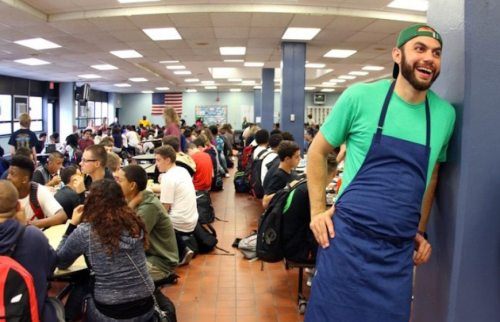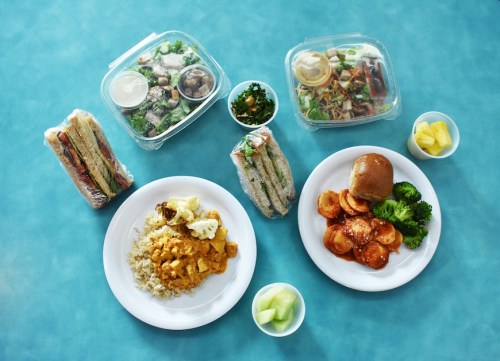Our editors independently select these products. Making a purchase through our links may earn Well+Good a commission
Why the world’s best chefs are leaving Michelin-star restaurants for public schools
Find out why some of the world's top chefs, including Noma's Dan Giusti, are leaving the restaurant industry to craft public school lunch menus.

Chef Dan Giusti is used to crafting cuisine for a high-stakes crowd. As the former head chef of Copenhagen’s Noma—which took the top spot in the coveted World’s 50 Best Restaurants list in 2014—people flew from around the world just to taste his dishes. “I was obsessed with feedback at Noma,” Giusti says. “There are only 24 tables and you can see everyone from the kitchen. I would Google who every person was, watch them while they ate, and take notes. These were people who would fly in from San Francisco on a private jet for lunch and would fly back after. You want to know: Did they leave having eaten the best meal they’ve ever had? That was the standard there.”
Now, having left Noma, Giusti is facing his toughest customers yet: public school kids.
Last year, Giusti launched Brigaid, a startup that recruits professionally trained chefs—many of which are James Beard Award winners—to lead public school kitchens, full-time. After a successful pilot program in New London, Connecticut, the program is expanding to New York City. And Giusti isn’t the only chef to swap meals that sell for over $300 to ones that cost less than $1 to make.
Scroll down to get schooled on how cafeteria food is getting an upgrade.

Why school lunches need a change
In not-so-shocking news, childhood obesity is a major problem in the United States right now: Nearly 14 million kids and teens in the US (or roughly one in six) are obese. This can lead to a whole slew of health problems later in life, including increased risk for diabetes, heart disease, and even anxiety.
Cafeterias serving up pizza and sodas daily certainly aren’t helping, which is why former New York City teacher Nancy Easton founded Wellness in the Schools (WITS) 13 years ago. The non-profit provides more access to healthy foods and teaches kids healthy habits they hope will stay with the students long after they graduate. Since its founding, WITS has expanded its reach from one school to 122, reaching over 60,000 students in New York, New Jersey, Florida, and California.
Eaton’s mission inspired Oceana executive chef Bill Telepan to sign on as WITS’s executive chef, working with the Department of Education to create an alternative menu of nutrient-dense meals. Other top chefs have lent their talents to the program by teaching cooking tutorials: Butter executive chef Alex Guarnaschelli, nutritionist and TV personality Ellie Krieger, and the Natural Gourmet Institute‘s Ann Nunziata.
“Over the past 10 years I’ve been working with WITS, the conversations around health have definitely changed,” Telepan says of the program’s impact. “Parents know about obesity and the diseases associated with it. The problem is access to healthy foods.” Which is exactly why WITS is using the schools as the entry point.
But chefs aren’t just seeing the cafeteria menu changes as a way to give back to their communities (and dial back a health crisis)—it’s proving to be a sound business model at the same time. Organic food brand (also known for their mushroom-growing kits) Back to the Roots is working with school districts in major cities such as New York, Chicago, Dallas, and Los Angeles to have their biodynamic cereal served instead of Kellogg’s. After winning a blind taste-test with kids, New York City began serving it in all public schools. The scenario is a win for both the kids, who get access to healthier breakfasts, and Back to the Roots, which is now moving a major amount of product.

Changing how school kitchens are run
With Brigaid, school districts pay a set fee for a chef to come in and oversee the school’s food service. (The chefs then become employees of the school district, on their payroll.) “The idea started because I was looking for a way to cook for a lot of people, every day,” Giusti says, emphasizing that that’s how you really nourish and take care of someone—not just by making them a nice meal (even if it’s a very nice meal) once in a while.
For Brigaid, Giusti has recruited a crew of talented chefs including former Coffee’s Country Market head chef Ryan Kennedy, Newport Restaurant Group executive sous chef April Kindt, and Copenhagen restaurant Bror chef Tyler Guerin. But they have to check their egos—and their tweezers—at the door. In the schools, simple, good-for-you food trumps anything too fussy.
“Last year on the first day of school, we served cut-up pineapple on a stick brushed with lime juice and dusted with chili pepper and lime zest. We froze them so they were like [ice-pops],” Giusti says. “But it turns out the kids really just wanted cut-up pineapple.”
“You can see an extra pep in these kids’ steps when they have something on their tray they’re excited about.” —Chef Dan Giusti
Believe it or not, students are hungry (literally) for healthy food. Giusti explains that federal regulations require that schools make available five categories of food: milk, fruit, a vegetable, a protein, and a grain. Every child must select three of those things to fill their plate, and one must be a fruit or vegetable. But often, the food isn’t appetizing enough for them to actually want to eat. He says the fruit option, for example, is often a low-quality apple at the end of the register. Not surprisingly, kids would take it and then just throw it in the trash. But when the fruit is diced and dressed with something simple, they’ll eat it. “Now, kids are actually taking more fruit than they’re supposed to—they take two or three servings of it,” Giusti says.
To serve food that’s tasty, nutritious, and cost-effective (Brigaid produces each meal for under $1), Giusti and his team level-up dishes the kids are already familiar with, like pasta, BLTs, composed salads, and warmed pastries like cornbread and biscuits. “You can see an extra pep in these kids’ steps when they have something on their tray they’re excited about,” Giusti says. “You can literally see on their faces how much they are enjoying everything.”
But he emphasizes that to him, it’s the relationships that are most important. “The interactions with people are always going to be more important that the interactions with food,” he says. “As a chef, you don’t want to think that or say that. You want to think the food you create is going to be the life-changing thing for people. But at the end of the day, it’s people.”

Why weekend eating needs attention, too
The People’s Bootcamp founder and The 30-Second Body author Adam Rosante was shocked when a friend of his told him about a school in Harlem where many of the students ate all three meals at the school from Monday through Friday through a federally subsidized programs—and then had nothing to eat on weekends. “It’s not an exaggeration,” he says. “They literally leave the school on Friday and don’t eat again until Monday.”
One in six children in the US suffer from a lack of access to food at some point during the year. “About 21 million children receive free or reduced lunch in school, and, of those, about 10 million also receive free breakfast. When schools close, about 18 million of those kids lose access to free meals in the summer,” Ross Fraser, director of media relations at Feeding America, tells Mashable. And the same problem surfaces every single weekend.
“A lot of people with good intentions [don’t actually end up helping] because they put a plate of kale in front of a kid who is used to eating nutrient-poor chicken fingers and the kids don’t want to eat it.” —Adam Rosante
Rosante came up with a simple solution to the problem: Giving kids in need an unmarked backpack (to prevent a stigma) full of food every Friday to last them through the weekend. His new non-profit Good Eats is currently being piloted at the aforementioned Harlem school. Inside each backpack are a breakfast, lunch, dinner, and two snacks for Saturday and Sunday. Then, Monday morning, the kids bring back the backpacks to be re-filled at the end of the week.
“Usually, the breakfast is a whole grain oatmeal, lunch is typically a vegetable-rich soup, the snacks are a fruit and a whole grain snack bar, and dinner is a living protein and a starchy grain, like chicken and rice,” Rosante says. He echoes Giusti’s mantra of keeping it simple: “A lot of people with good intentions [don’t actually end up helping] because they put a plate of kale in front of a kid who is used to eating nutrient-poor chicken fingers and the kids don’t want to eat it.” Like Giusti, he emphasizes that the key is providing nutrient-rich versions of foods they already know and love.
If you think about it, a lot of the foods you crave now were probably your fave foods as a kid. (Hello, gooey mac and cheese!) What kids are learning in the classroom is important—but so is what they learn in the cafeteria.
When it comes to eating at home, here’s how to meal-plan when your child has a food sensitivity. And the real answer on if it’s healthy to raise your child vegan or not.
Sign Up for Our Daily Newsletter
Get all the latest in wellness, trends, food, fitness, beauty, and more delivered right to your inbox.
Got it, you've been added to our email list.










